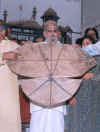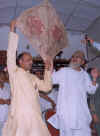|
|
|
||||
|
June 2002 Contents Mt. Everest -
beginning of 50th Sherpas - the
Real Men who K2 - an account
of a winter Lifestyle Super Achievers & Success Shovana
Narayan, Sidhartha
Sahir Raza - capturing Gujarat
Sports Baba Saheb - the
grand old
'Ananda' spa in
Garhwal
Indu Gupta's new
dimension 'Knock
at Every Alien Door'
Books
|
|
|
|||
| print gallery | |||||
|
BABA SAHEB - the grand-old man of kite flying by Sanjeeb Mukherjee A strong proponent of the Indian ‘fighter kites’, Baba Saheb has also launched an organization called the Manjha Association of India and helps organize several tournaments to keep this art alive amongst young people.
67-year-old Nasir Mian or Baba Saheb, as his followers fondly call him, is considered the grand-old man of kite flying. No professional competition is complete without the presence of this bearded man from Bareilly. For him, kite flying is a hobby which has now become an obsession. Grandson of Baba Farid, the great Sufi saint, Baba Saheb had an upbringing which was very unlike other kids of his age. Being the descendent of a holy man he was required to undergo rigorous training in religion and was forbidden from indulging in any sort of ‘wasteful entertainment’ or to participate in anything even remotely pleasurable. Confined to the four walls of his house, the only leisure activity permitted for the then young boy was the sport of kite flying from the rooftop of his sprawling mansion in Bareilly. " Since this was my only source of diversion, it was but natural that I’d fall in love with kite flying and kites," says Baba Saheb. Knowing the boy’s predilection for kites, even the teachings that his father and other religious leaders imparted veered around the patang (kite). Baba Saheb gives a sampler, " The kite symbolizes the human body and the string attached to it is the soul, the person holding the string is the Almighty. In this way even the most complex religious doctrines were imparted to me in a language understood." Since then it has been six decades of kite flying. Even today as the sun sets and kites start dotting the Bareilly skyline, Baba Saheb and his team are there with their patangs, manjhas and chakris. As soon as his players bring down an opponent’s kite, this 67-year-old Baba jumps with child like joy. It seems age has done little to put on hold the enthusiasm of this man and his colourful kites. Therapeutic
Baba Saheb was in the capital recently to participate in the National Kite Flying Festival. He says the sport is now in his blood. " When I was very young I would come back after a long day of studies and start flying kites till sunset. That was and still is my best technique of unwinding." Nothing unusual about the hobby. But what makes Baba Saheb so special is that he has a virtual museum of kites at his haveli in Bareilly. He has a collection of rare kites some of which are over 200 years old. He has inherited these vintage kites as part of his family legacy. The pride of his collection is a battle-weary veteran 207 year-old kite which was flown by one of his ancestors. "Traditionally we are a family of fakirs [religious teachers] and for us kite flying is a passion that is intertwined with religious imagery. That’s why we take it so seriously," says Baba Saheb. He doesn’t trust the manjha [thread] available in the market but prefers to make his own at home. The secret of successful kite flying is in its string. And Baba Saheb has access to some of the best-kept secrets of making razor-sharp string which he says has been given to him by his father and which he will never share with anyone else. To him kite flying is much more than just a hobby, he is fully committed to the cause of promoting the unique Indian sport of ‘fighter kites’. He even sends trained people abroad to teach this art form. His home in Bareilly is like a school for kite fliers and even his sons and relatives have joined in popularising this art. Tracing back the history, Baba Saheb says that though no one knows when people started flying kites, most experts take it around 14 century BC, when a Greek physician Lukhwan flew a kite-like object to test how far the visually impaired prince of Greece could see. Fascinated by the flying object, some enterprising people adopted it as a sport by adding a tail to it. Later kites moved out of Greece and travelled to India, China, Mongolia, Europe, Thailand and Japan. In the last two centuries kites were extensively used in wars to send signal to the troops, even to explode bombs over enemies. In some countries like China kites had a deep association with religion and were made in the shape of various Buddhist motifs like tortoise, birds and dragons. Even as they soared the skies they were said to bring one closer to God. India developed a rich tradition of kite flying due to the patronage of the Kings and Nawabs who found the sport both entertaining and a way of displaying their prowess. Trained fliers were employed to fly kites for kings. Slowly, this art started getting popular amongst the masses. But there was a big difference. India was the only country that turned kite flying into a competitive sport. Even today the shape and size of the Indian kites is distinctly different from those made elsewhere in the world. Fighter Kites
" Our kites are lighter and do not necessarily have a tail. They are ‘fighter kites’ and the focus is more on developing the technique of ‘cutting’ the opponent’s kite than on anything else," says Baba Saheb. Special strategies are adopted to anticipate the moves made by the opponent and counter- moves are planned accordingly. In many cities and towns of U.P., Rajasthan and Madhya Pradesh, kite flying is a complete art that requires multiple skills of good eyesight, mental agility, physical fitness and a sense of anticipation. As Baba Saheb puts it, " India is the only country apart from Pakistan and Bangladesh [earlier part of India] where you get ‘fighter kites.’ In other parts of the world, kites are mostly ornamental or have religious sentiments attached to them". Painch or the art of entangling the opponent’s kite and ‘cutting’ it requires the skills of a master. And this skill can take years to hone. A lot depends on the sharpness of the string to which the kite is attached. A combination of rare herbs, glass powder, sand and glue are applied to thick ordinary string to sharpen it. In the olden days some kings are said to have applied diamond shrapnel to give the manjha its cutting edge. Kite flying has traditionally been an all-family sport in many parts of India where people of all age groups gather on rooftops generally on Basant Panchami day to fly kites. Baba Saheb is convinced that kite flying has numerous benefits apart from being a clean and safe entertainment. " It provides good exercise, the spirit of competition and keen observation makes a person alert. Kites directly or indirectly provide employment to thousands of people. In Bareille alone there are 30,000 trained artisans who specialize in making manjha," claims Baba Shaheb. A strong proponent of the Indian ‘fighter kites’, Baba Shaheb has also launched an organization called the Manjha Association of India and helps organize several tournaments to keep this art alive amongst young people. "Organizing festivals that display decorative kites won’t help promote the ‘fighter kites’ of India. This tradition can be kept alive only by holding tournaments in small towns and villages. A lot of government assistance is required." Unavailability of grounds, paucity of funds and lack of training facilities are the main reason why this unique art form is dying in our country, says Baba Saheb who plans to start a countrywide movement with a little help from the government. " It is one of India’s richest traditions but sadly the interest is dwindling in this ancient sport. Today’s young people are spending their time sitting in front of TV sets. They are not just missing out on good work out opportunities that kite flying provides but also the entertainment of this team sport. I plan to change all that." But till the change happens the old man of kites is happy soaring the skies solo. _____________
|
|||||
| Copyright © 2002 [the-south-asian.com]. Intellectual Property. All rights reserved. | |||||
| Home | |||||


